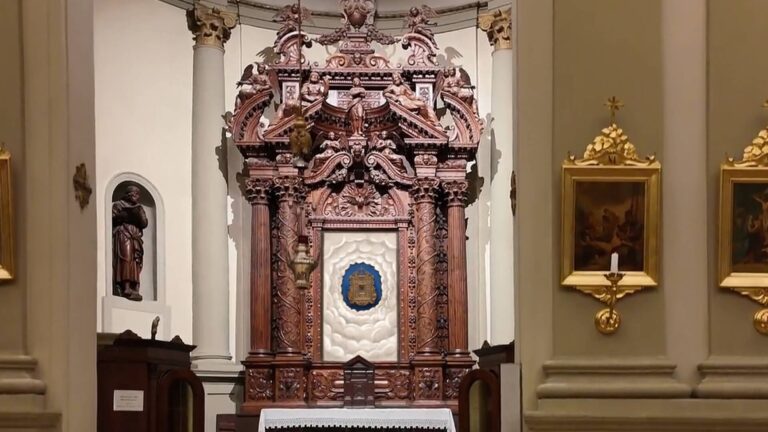ARTISTS’ ROADS
LE VIE DEGLI ARTISTI
watch the videos at the bottom of the page!
CORDIGNANO
A Monumental Wooden Altarpiece for a Small, Deeply Venerated Marian Image
The archpriestal church of Cordignano has a distinctive form. A single nave, flanked by two centrally planned side structures. So oversized, they seem like buildings in their own right.
Inside, the two chapels appear truly majestic. The one on the left is dedicated to Saint Francis of Assisi. It houses a monumental seventeenth-century wooden altarpiece, finely carved and sculpted. It is completed by a seventeenth-century painting of the Crucifixion with Saints.
But this is not its original configuration. And the dedication is not original either.
To help us reconstruct its history, we turn to two precious sources. A photograph from 1951 and a document dated 8 December 1647.
Let us begin with the photograph. In black and white, we can glimpse the altar.
Curiously, at the centre of the reredos we do not find the painting of the Crucifixion with Saints, but instead a small reliquary. Painted clouds frame it. And a cord descends from above. What are we looking at?
You only need to visit the Chapel of the Rosary today to find that same reliquary. It is made of gilded wood, and it holds a small image.
A fragment of rectangular cloth, just over eight centimetres tall, on which is printed an image of the Crowned Virgin holding the Christ Child in her arms.
It resembles a scapular, or more precisely, part of a scapular. An object closely linked to the Carmelites, a distinctive sign of Marian devotion, given to laypeople affiliated with the order and gathered in confraternities.
It takes the form of a necklace, made of two rectangular sacred images connected by cords, to be worn beneath clothing.
But where does the miraculous image of Cordignano come from?
According to tradition, in 1641, a man named Paolin De Pol of Ponte della Muda received it as a gift from a friar, during a pilgrimage to a sanctuary dedicated to Our Lady of Mount Carmel. Revealed to be miraculous, it was placed in a wayside shrine, where large numbers of pilgrims came to venerate it and left monetary offerings.
Devotion grew to such an extent that on 8 April 1643, the image was permanently moved to the church of Cordignano, where a chapel was built for it, and the Confraternity of the Most Blessed Virgin of Mount Carmel was established.
And here is the document dated 8 December 1647. It is a contract between the confraternity and the renowned Ghirlanduzzi workshop of Ceneda, represented by Giambattista and his brother Andrea.
The agreement concerns the construction of an altar dedicated to Our Lady of Mount Carmel, intended to house the Marian image. The contract lists the main requirements for the work. The dimensions—monumental. The choice of wood—Swiss pine. The number of angels to be carved, and their purpose. The price. The payment schedule. The transport. And the installation of the finished work.
It is almost certain that this same workshop created the gilded wooden reliquary that still holds the image today.
The result is a complex and dynamic architectural machine, Baroque in style, in which architectural elements, vine tendrils, garlands of fruit and foliage, angels and prophets coexist in harmonious splendour.
And if we look closely, behind the altarpiece, that painted cloud-frame still exists, as does the pulley and cord system.
A grand and refined stage, complete with curtain, to house this small and deeply venerated image of the Virgin Mary!
MORE EXPERIENCES!
Quando il legno dà forma al sacro:
- Il coro ligneo nella parrocchiale di Visnà
- Gli altari del Novecento nell’abbazia di Follina
- La Madonna vestita nel santuario di Miane
- La Crocifissione di Giovanni Possamai nel duomo di Pieve di Soligo
MULTIMEDIAL MAP: “ARTISTS’ ROADS – LE VIE DEGLI ARTISTI- EN”!

